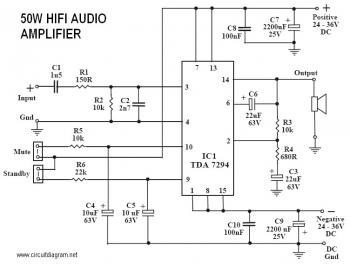Parts list:
| R1 = 150R R2, R3, R5 = 10K R4 = 680R R6 = 22K IC1 = TDA 7294 Heatsink | C1 = 1u5F or 1u C2 = 2n7F C3, C6 = 22uF 63V C4, C5 = 10uF 63V C7, C9 = 2200uF 50V C8, C10 = 100nF |
This is a great audio amplifier circuit is based on the power IC TDA7294. TDA7294 is intended for use as class AB amplifier in hi-fi audio applications. It's very quiet of noise and distortion, has wide bandwidth and high output current capability, so that we can provide high power at both 4Ω and 8Ω loads. TDA7294 has both short-circuit and thermal protection, so it is strong enough.
With the addition of a handful of parts and a suitable power supply, this module will deliver over 50W RMS into 4 or 8 ohms with < 0.1% Total Harmonic Distortion (THD) and < 0.1% Intermodulation Distortion (IMD). A similar circuit was published in Elektor magazine, 11/96.
It is also suitable as a replacement power amplifier stage, or upgrade for many existing amplifiers of between 30W-50W, provided they have a suitable dual supply, and most do.
Download the explanation of TDA7294 amplifier circuit include the diagram in pdf format HERE
About Audio Amplifier
An audio amplifier is an electronic amplifier that amplifies low-power audio signals (signals composed primarily of frequencies between 20 - 20 000 Hz, the human range of hearing) to a level suitable for driving loudspeakers and is the final stage in a typical audio playback chain.
The preceding stages in such a chain are low power audio amplifiers which perform tasks like pre-amplification, equalization, tone control, mixing/effects, or audio sources like record players, CD players, and cassette players. Most audio amplifiers require these low-level inputs to adhere to line levels.
While the input signal to an audio amplifier may measure only a few hundred microwatts, its output may be tens, hundreds, or thousands of watts. More explanation about power audio amplifier can be found at wikipedia.org
An audio amplifier is an electronic amplifier that amplifies low-power audio signals (signals composed primarily of frequencies between 20 - 20 000 Hz, the human range of hearing) to a level suitable for driving loudspeakers and is the final stage in a typical audio playback chain.
The preceding stages in such a chain are low power audio amplifiers which perform tasks like pre-amplification, equalization, tone control, mixing/effects, or audio sources like record players, CD players, and cassette players. Most audio amplifiers require these low-level inputs to adhere to line levels.
While the input signal to an audio amplifier may measure only a few hundred microwatts, its output may be tens, hundreds, or thousands of watts. More explanation about power audio amplifier can be found at wikipedia.org
This is a video tutorial about how to a very simple audio amplifier based on the LM386 amplifier chip. It can be built for less than $20 (or might be less than $8 in some countries) and used to amplify any low level audio signal including a guitar, bass or mp3 player.
Watch the video:

No comments:
Post a Comment